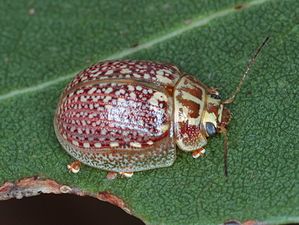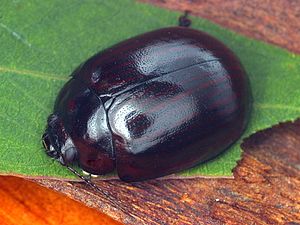
Chrysolina is a large genus of leaf beetles in the subfamily Chrysomelinae. Most species are distributed in Europe, Asia and Africa with a small number of species inhabiting North America and introduced species in Australia.

Paropsis is a genus of Chrysomelidae, commonly referred to as tortoise beetles, which includes over 70 described species. Their small size, bright colours and patterns, and roughly hemispherical shape cause them to be mistaken for beetles in the family Coccinellidae (ladybirds). They are distributed across Australia, New Zealand and Papua New Guinea. They primarily feed on Eucalyptus but there are a few that feed on Baeckea, Kunzea and Leptospermum. Species within this genus are noted as pests. For example, Paropsis charybdis is a pest of Eucalyptus in New Zealand.
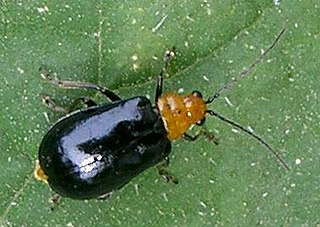
Aulacophora is a genus of beetles in the family Chrysomelidae, commonly known as pumpkin beetles; some species are pests of agricultural crops. The genus was named in 1836 by the French entomologist Louis Alexandre Auguste Chevrolat, in Dejean's Catalogue des Coléoptères. The name, from Ancient Greek, signifies "furrow-bearer"' from aulax, "furrow".
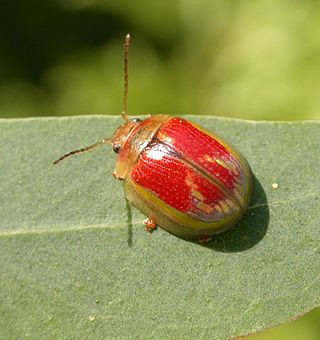
Paropsisterna selmani, the Tasmanian Eucalyptus Beetle, is a species of leaf beetle native to Tasmania which has been inadvertently introduced to the Republic of Ireland and United Kingdom. It is the first eucalyptus-feeding chrysomelid known to have become established in Europe.
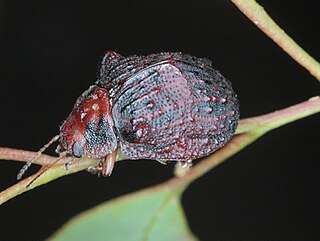
Trachymela is a genus of beetles, commonly called leaf beetles and in the subfamily Chrysomelinae. These beetles are usually brown or black and have elytra with verrucae (bumps) and lacking striae. Trachymela can be found in all states of Australia There are over 120 species.

Dicranosterna is a genus of leaf beetles, in the subfamily Chrysomelinae.
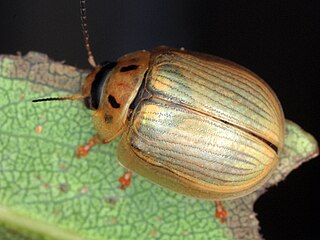
Paropsisterna bimaculata is a beetle commonly called a leaf beetle in the subfamily Chrysomelinae.This insect is common in Tasmania and can be a pest in the forestry industry. Paropsisterna bimaculata will develop a red color just before their winter hibernation. When they emerge the red slowly disappears into a pale green colouring with faint gold tessellation. This takes about a month with the males generally slightly advanced. Recently this beetle has been noticed in Victoria.
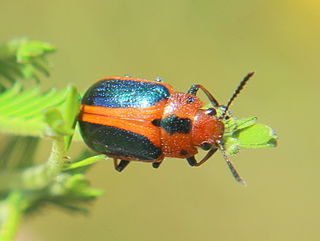
Calomela is a genus of beetles commonly called leaf beetles and in the family Chrysomelidae. They are specialist feeders on various species of Acacia and are not reported as a problem species. The beetles are cylindrical when compared with other leaf beetles and their larvae are globose. Calomela includes about 45 species which are found in all states of Australia.

Chalcolampra is a genus of leaf beetles. These beetles are widespread from Southeast Asia to Australia and New Zealand, but most common in the southeast of Australia. There are approximately 25 Australian species within this genus. There are also 13 species described from New Zealand, with up to an additional 20 undescribed species from the South Island.

The Spilopyrinae are a small subfamily of the leaf beetles, or Chrysomelidae. They occur in Australia, New Guinea, New Caledonia and Chile. They were formerly considered a tribe of the subfamily Eumolpinae. The group was elevated to subfamily rank by C. A. M. Reid in 2000. However, some authors have criticised this placement, preferring to retain them within the Eumolpinae.

Eumolpini is a tribe of leaf beetles in the subfamily Eumolpinae. It is the largest tribe in the subfamily, with approximately 170 genera found worldwide. Members of the tribe almost always have a longitudinal median groove on the pygidium, which possibly helps to keep the elytra locked at rest. They also generally have a subglabrous body, as well as appendiculate pretarsal claws.

Chalepus is a genus of tortoise beetles and hispines in the family Chrysomelidae. There are more than 90 described species in Chalepus.
Eboo is a genus of leaf beetles in the subfamily Eumolpinae. It is endemic to Australia, and contains approximately 50 species. Many of these species show strong sexual dimorphism, and they feed primarily on Eucalyptus plants.
Edusella is a genus of leaf beetles in the subfamily Eumolpinae. They occur in Australia.
Hylax is a genus of leaf beetles in the subfamily Eumolpinae. It is distributed in Central America and South America.
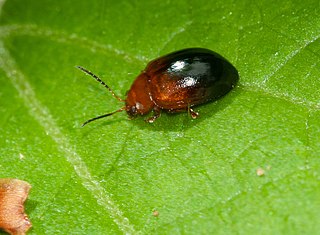
Nisotra is a genus of flea beetles in the family Chrysomelidae. They are found in Africa, Asia, and Australia. There are around 90 described species in Nisotra, including about 70 in Sub-Saharan Africa and Madagascar. Many of these species are agricultural pests.





